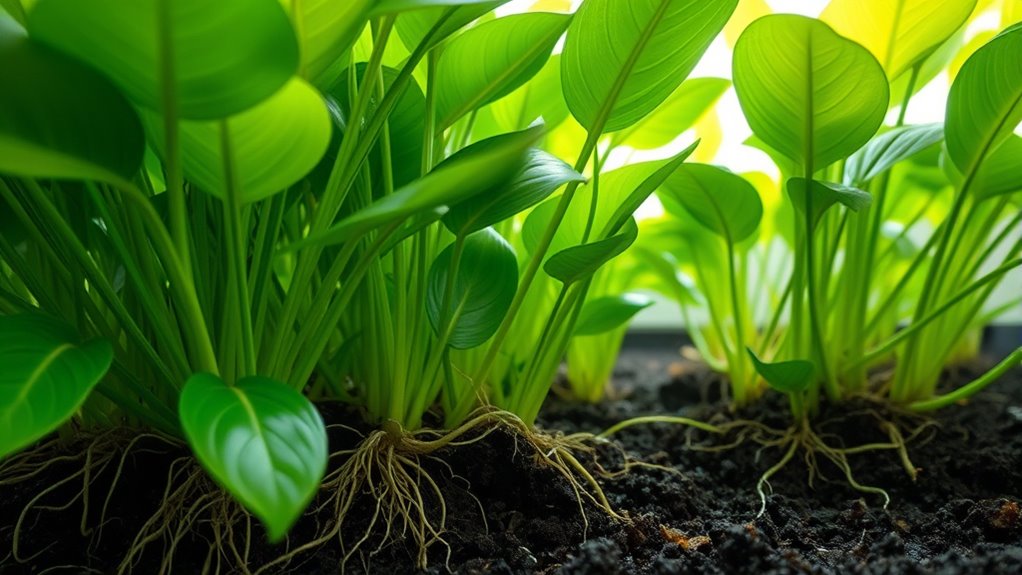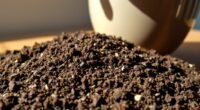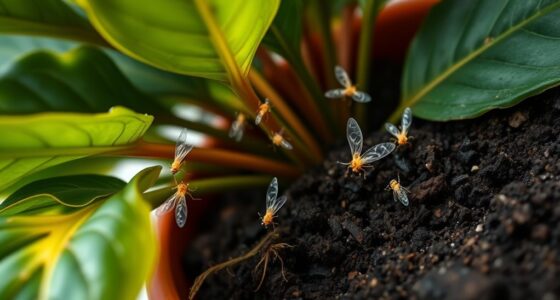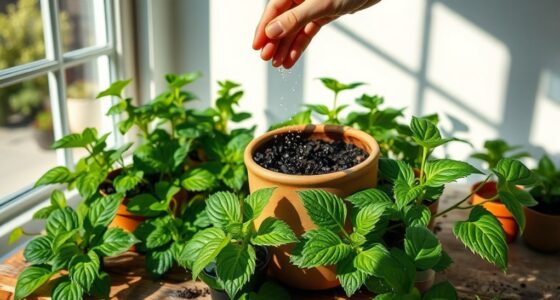To harness beneficial fungi like mycorrhizae for healthier indoor plants, start by using inoculants or compost teas during repotting. These fungi form partnerships with your plant roots, boosting nutrient absorption, especially phosphorus, and strengthening root systems. Maintaining consistent moisture and avoiding fungicides help establish these beneficial networks. Creating the right environment encourages fungal growth, leading to stronger, more resilient plants. Keep exploring to discover how to optimize this natural process for vibrant indoor greenery.
Key Takeaways
- Introduce mycorrhizal inoculants during planting to enhance nutrient absorption and root development.
- Maintain consistent moisture and avoid fungicides to support fungal colonization and growth.
- Use self-watering pots to create optimal conditions for beneficial fungi in indoor environments.
- Incorporate compost teas or commercial inoculants to establish and sustain healthy fungal networks.
- Reduce heavy fertilization to promote natural symbiotic nutrient exchange between fungi and plants.
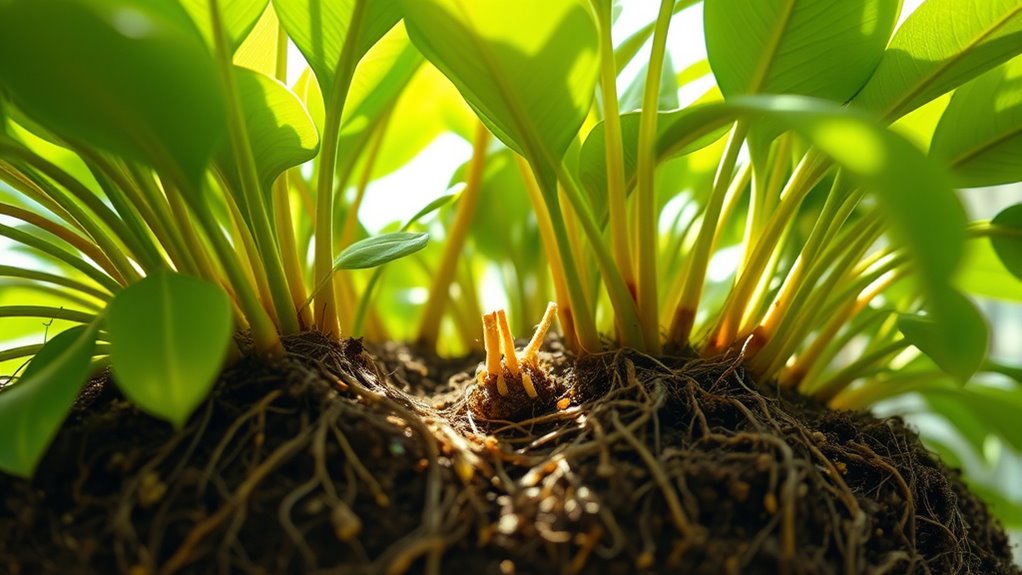
Indoor plants can thrive when you introduce beneficial fungi into their soil, as these microbes boost nutrient absorption and improve overall health. One of the most effective ways to do this is by encouraging fungal root associations, commonly known as mycorrhizae. These fungi form a symbiotic relationship with your plants’ roots, enhancing their ability to access nutrients and water from the soil. When you add mycorrhizal fungi, you’re essentially creating a partnership where both the plant and fungi benefit through a process called symbiotic nutrient exchange. This exchange allows the fungi to extend the plant’s root system via their hyphae, which are tiny filaments that reach much farther than roots alone. As a result, your indoor plants can absorb more nutrients, especially phosphorus, which is crucial for energy transfer and root development.
The presence of these fungi can considerably improve the resilience of your plants, making them more resistant to stress and disease. When you introduce mycorrhizae, you’re helping establish a network that enhances nutrient and water uptake, which is particularly useful in indoor environments where soil nutrients can be limited. The fungi help your plants access nutrients locked in the soil, making fertilization more efficient. This means you don’t need to rely on heavy feeding, reducing the risk of over-fertilizing and soil imbalance. Additionally, fungal root associations can help protect your plants from root pathogens by occupying space and resources that potential invaders might otherwise exploit. Using self watering plant pots can further support these beneficial relationships by maintaining consistent moisture levels, which are vital for fungal colonization.
To harness these benefits, you should use commercial mycorrhizal inoculants or compost teas that contain beneficial fungi. When applying, make sure to follow instructions carefully, and consider mixing the inoculant into the soil during repotting or planting. Consistent application can establish a healthy fungal network that supports your indoor plants’ growth long-term. Remember, the success of fostering symbiotic nutrient exchange depends on maintaining a healthy soil environment—avoid overwatering, ensure proper drainage, and steer clear of fungicides that may kill beneficial fungi.
Frequently Asked Questions
Can Beneficial Fungi Prevent Indoor Plant Pests?
Beneficial fungi can help prevent indoor plant pests by boosting soil enrichment and enhancing pest resistance. When you introduce mycorrhizae, they improve nutrient uptake and strengthen plant health, making it harder for pests to establish. By fostering a healthier root system, these fungi create a natural barrier against pests, reducing the need for chemical treatments. So, using beneficial fungi is a smart way to maintain pest-resistant, thriving indoor plants.
Are Mycorrhizae Safe for Pets Around Indoor Plants?
While the idea of introducing beneficial fungi might seem like a gentle hug for your plants, you wonder about plant safety and pet health. Generally, mycorrhizae are safe around pets when used properly, as they’re naturally occurring and non-toxic. Just make certain you follow application instructions carefully, keep pets away during treatment, and monitor your animals. This way, your indoor garden stays healthy without risking your furry friends’ well-being.
How Often Should I Apply Fungi to Indoor Plants?
You should apply fungi to your indoor plants based on their needs and the product instructions. Typically, application frequency ranges from once every few months to quarterly, ensuring fungal reapplication supports healthy root development. Keep an eye on plant health; if you notice signs of stress, you might need to adjust the fungal reapplication schedule. Always follow the specific guidelines on your fungal product for the best results.
Do Fungi Improve Indoor Air Quality?
Fungi can improve indoor air quality indirectly by enhancing soil health, which leads to healthier plants. When your plants thrive, they absorb more carbon dioxide and release oxygen, aiding in air purification. While fungi don’t directly purify air, their role in supporting robust root systems promotes vigorous growth and healthier foliage, contributing to cleaner indoor environments. So, fostering beneficial fungi helps your plants do their best in improving overall air quality.
Can Fungi Help Revive Dead or Severely Stressed Plants?
If your plants are dead or severely stressed, fungi can aid soil revival and boost plant resilience. You might consider applying mycorrhizal fungi, which form symbiotic relationships with roots, helping plants absorb nutrients more effectively. While fungi can’t revive completely dead plants, they can notably improve the health of stressed ones, giving them a better chance to recover by strengthening their root systems and promoting overall vitality.
Conclusion
By now, you see how mycorrhizae can transform your indoor garden into a thriving oasis. These beneficial fungi boost plant health, improve nutrient uptake, and foster stronger roots. Imagine walking into your home, greeted by lush, vibrant plants that seem almost alive with vigor. Wouldn’t you want to give your indoor plants the best chance to flourish? Embrace the power of fungi and watch your indoor space come alive with greenery and growth.

